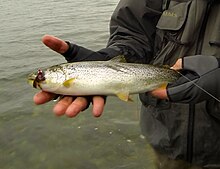Oncorhynchus clarki clarki
| Coastal cutthroat trout | |
|---|---|
 |
|
| Scientific classification | |
| Kingdom: | Animalia |
| Phylum: | Chordata |
| Class: | Osteichthyes |
| Order: | Salmoniformes |
| Family: | Salmonidae |
| Genus: | Oncorhynchus |
| Species: | O. clarkii |
| Subspecies: | O. c. clarkii |
| Trinomial name | |
|
Oncorhynchus clarkii clarkii (Richardson, 1836) |
|
The coastal cutthroat trout (Oncorhynchus clarkii clarkii) also known as the sea-run cutthroat trout, or harvest trout is one of the several subspecies of cutthroat trout found in Western North America. The coastal cutthroat trout occurs in four distinct forms. A semi-anadromous or sea-run form is the most well known. Freshwater forms occur in both large and small rivers and streams and lake environments. The native range of the coastal cutthroat trout extends south from the southern coastline of the Kenai Peninsula in Alaska to the Eel River in Northern California. Coastal cutthroat trout are resident in tributary streams and rivers of the Pacific basin and are rarely found more than 100 miles (160 km) from the ocean.
Adults migrate from the ocean to spawn in fresh water. Juveniles migrate to the sea where they feed and become sexually mature before returning to fresh water to overwinter and spawn. Unlike steelhead and Pacific salmon, coastal cutthroat do not make lengthy migrations out to sea. Generally speaking, coastal cutthroat will remain in or near estuarine waters, usually within 5–10 mi (10–15 km) of their natal stream. Some cutthroat, however, have been shown to move as far as 70 mi (110 km) into the open ocean. There are also lacustrine and riverine populations that spend their entire lives in freshwater. One such population is the trout of Lake Crescent in Washington state that was formerly considered to be a separate subspecies called the Lake Crescent cutthroat trout, Oncorhynchus clarkii crescenti.
Cutthroat trout were given the name Salmo clarkii in honor of William Clark, who co-led the expedition of 1804–1806. One of Lewis and Clark's missions was to describe the flora and fauna encountered during the expedition. The type specimen of S. clarki was described by naturalist John Richardson from a tributary of the lower Columbia River, identified as the "Katpootl", which was perhaps the Lewis River as there was a Multnomah village of similar name at the confluence. This type specimen was most likely the coastal cutthroat subspecies. In 1989, morphological and genetic studies by Gerald R. Smith, the Curator of Fishes at the Museum of Zoology, and Ralph F. Stearley, a doctoral candidate at Museum of Paleontology (University of Michigan) indicated trout of the Pacific basin were genetically closer to Pacific salmon (Oncorhynchus species) than to the Salmos–brown trout (S. trutta) or Atlantic salmon (S. salar) of the Atlantic basin. Thus, in 1989, taxonomic authorities moved the rainbow, cutthroat and other Pacific basin trout into the genus Oncorhynchus.
...
Wikipedia
